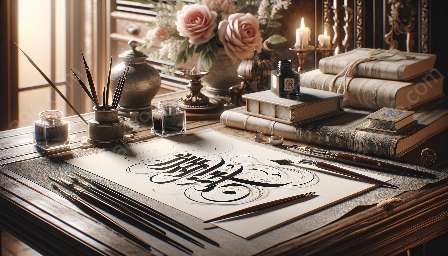Calligraphy has long been revered as a sophisticated art form, with its roots in both linguistic expression and visual aesthetics. Moreover, when exploring calligraphy from a spatial design perspective, we uncover a profound synergy between the two disciplines as advanced calligraphy techniques influence and shape spatial design in unique and compelling ways.
The Essence of Calligraphy
Before delving deeper into the relationship between calligraphy and spatial design, it's essential to understand the essence of calligraphy itself. At its core, calligraphy is the art of beautiful writing, with a focus on the visual expression of language through skilled hand movements and precise strokes. It embodies balance, rhythm, and harmony through the diverse styles and scripts employed across different cultures and histories.
Understanding Spatial Design
On the other hand, spatial design encompasses the arrangement and organization of physical and visual elements within a given space. It involves the strategic manipulation of form, color, light, and materials to evoke emotional responses and create functional, aesthetically pleasing environments. This multidisciplinary field draws from architecture, interior design, and graphic design to craft immersive experiences and interactive spaces that resonate with inhabitants and visitors.
The Synergy Unveiled
As we delve into the relationship between calligraphy and spatial design, there are several key ways in which advanced calligraphy influences and intertwines with the principles of spatial design:
- 1. Visual Harmony and Balance: Advanced calligraphy techniques, such as the use of varied line weights, flourishes, and intricate compositions, contribute to the visual harmony and balance within a spatial layout. Just as calligraphers meticulously consider the interplay of negative space and form, spatial designers strategically orchestrate the arrangement of elements to create a harmonious visual narrative.
- 2. Typography as Spatial Element: In advanced calligraphy, the interplay of typography and negative space is a defining aspect. Similarly, in spatial design, typography extends beyond two-dimensional surfaces to become a spatial element, integrated seamlessly into architectural environments and interior spaces. This fusion blurs the boundaries between calligraphic forms and spatial compositions, offering new dimensions for design exploration.
- 3. Cultural Context and Narrative: Advanced calligraphy often carries cultural significance and historical narratives within its scripts and styles. When integrated into spatial design, calligraphic elements become potent storytellers, infusing spaces with rich cultural context and evocative narratives. They serve as compelling focal points that invite exploration and contemplation, bridging the realms of language, visual art, and spatial experience.
- 4. Expressive Gestures and Form: The expressive gestures and fluid forms characteristic of advanced calligraphy impart a sense of dynamic movement and energy. Spatial design leverages this dynamism to craft fluid environments that engage and guide occupants through intentional flows and pathways, creating immersive experiences that resonate with the calligraphic spirit of expressive movement.
Integration and Innovation
The integration of calligraphy into spatial design presents boundless opportunities for innovation and creativity. Advanced calligraphy techniques serve as a wellspring of inspiration, offering spatial designers a rich palette of expressive forms, cultural motifs, and visual languages to weave into their designs. This fusion transcends mere ornamentation, evolving into a deeply integrated design ethos that resonates with the human experience, cultural diversity, and the evolving dynamics of spatial storytelling.
Conclusion
Calligraphy, as a form of spatial design, transcends the conventional boundaries of art and design. Its fusion with spatial design propels the creation of environments that embrace cultural narratives, evoke emotional resonances, and celebrate the expressive beauty of language. By exploring the interplay between advanced calligraphy and spatial design, we uncover a realm of design possibilities that harmonize the art of writing with the art of spatial storytelling.

